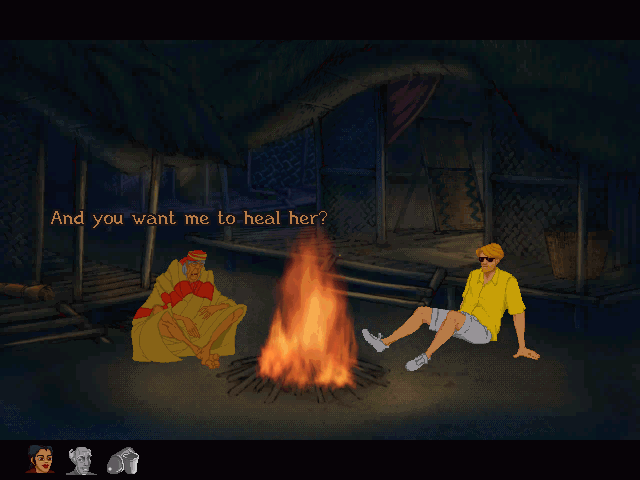
Broken Sword II: The Smoking Mirror
Written by: Rik
Date posted: June 2, 2007
- Genre: Adventure
- Developed by: Revolution
- Published by: Virgin Interactive
- Year released: 1997
- Our score: 6
While the world may not exactly have been clamouring for the return of intrepid tourist George Stobbart and his tissue-touching antics, it’s fair to say that the once Broken Sword proved relatively popular with press and public alike, a sequel was always on the cards. Despite a few flaws, the original was a nice enough game, and I actually ended up enjoying it a lot more than I thought I would (you can read the review here) – to the extent that I was actually quite looking forward to the second instalment.
Obviously I can’t have been looking forward to it that much, as a quick check of the review dates tells me that it’s getting close to a year since we covered the original on FFG. Perhaps I just needed a break from hearing George’s voice over and over again – sometimes when I wasn’t even playing the game. Anyway, sure enough, another sword has been, er, broken, and once again Mr Stobbart has been called upon to don his green jacket and travel around the world irritating the hell out of the inhabitants of an alarmingly large number of nations.
A number of months have passed since George’s first adventure, and we join the action back in Paris, where he and his journalist friend Nicole have been mysteriously called to the house of a noted French archaeologist. Unsurprisingly, things soon start to go pear-shaped, and you soon find yourself in more trouble than the time a bomber dressed as a clown decided to visit the same cafe as you. Once you get out of the initial merde, you embark once more on a quest across Europe and the rest of the world unravelling the mystery by talking to locals, fiddling about in museums and generally doing the same kinds of things you did in the first game.
Wisely, Revolution didn’t decide to do anything too drastic with the game, and rather than making a futuristic, ultra-violent golf sim set in post-apocalyptic Japan, they’ve produced another point and click adventure which is essentially very similar to the first game. In many ways, it’s a superior experience. The graphics are as superb as before, with the beautifully drawn backdrops now being complemented by improved moving graphics, in particular the characters themselves, which are now more detailed and don’t blur so easily at close range. The sound has also been improved, with most of the dodgy accents from the first game notable by their absence (bar one or two exceptions) and generally lines are delivered in a more convincing manner by the voice talent involved.
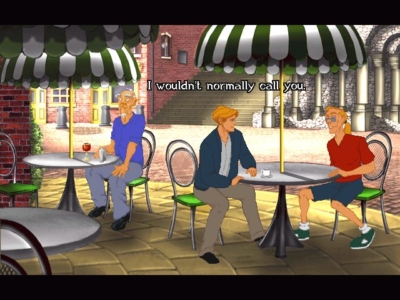
The ponytailed twerp from the first game makes another appearance. He’s still trying to crack onto your woman.
This goes for George, too. Although he seems relatively unchanged from the original game (and is voiced by the same actor as before), he seems a more well-rounded character than last time around. Okay, he’s still annoying, but his behaviour is now a lot more consistent, and his occasional bizarre and oddly tasteless remarks seem to have all but disappeared from his script for this game. Clearly, this is a good thing, and it certainly aids your enjoyment of the whole experience to have a central character that you can at least identify with. After a hectic start, the game takes a little time to let you wander around Paris, chat to people and reveal what George has been up to since the events of the first game, and it was all done so well, I actually found myself taking to the bloke a little. And, as you progress through the game, it’s quite a nice surprise to find him not acting like a total douchebag at every turn.
Elsewhere in the sound department, the music is still pretty well put together and you still get nice ‘reaction’ music whenever you make an important discovery. Unfortunately, this still tends to come on a little strong, with a grand flourish accompanying each and every minor discovery, but even so it’s quite nice to have it there rather than the same score mindlessly spooled in off a CD.
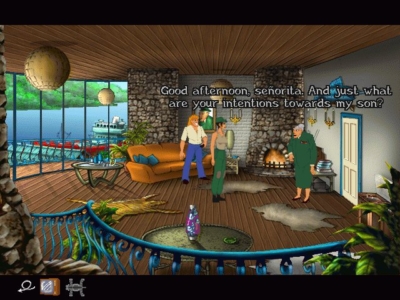
In this sequence, Nico has to buy some time for George by making small talk with this sleazy dude and fending off his mother.
In terms of changes to the gameplay, it’s pretty much the same as before. There are, however, a couple of noticeable differences. One relatively major innovation sees player control shift from George to Nicole at various stages throughout the game. At certain points you’ll send George bumbling off into the distance and the scene changes to reveal Nicole in a different, often perilous, situation. As an idea it’s nice enough, although unfortunately it’s not really been realised to its full potential. Nicole rarely has much in her inventory, and rarely has much chance to explore, so the scenes when you take control of her usually amount to solving a couple of simple puzzles across one or two screens in order to progress.
In fact, as a whole the game is very linear, even more so than the previous game and many other adventure titles. Put simply, you aren’t really given any freedom to explore different locations in a bid to solve the game’s various puzzles. Most of the time you’re locked into a certain scene, usually with a maximum of three or four different locations, and are forced to remain there until you complete the handful of puzzles required to progress the story. While normally I’m a fan of adventure games that help focus the player’s attention on what they have to do rather than forcing them to wander around aimlessly attempting various unlikely combinations from their inventory, it’s really taken to extremes here, to the extent that the map screen from the first game has disappeared completely, and only in the game’s opening scenes are you ever given any choice as to where you should go next.
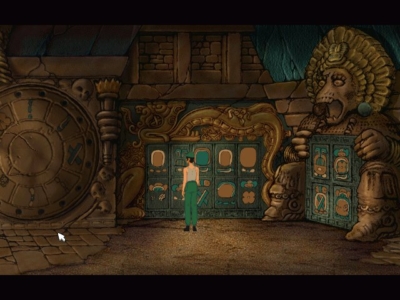
If you reckon an adventure isn’t complete without a ridiculous symbol-based puzzle, you’ll be in for a treat here.
A couple of other negatives unfortunately also have to be noted. While the story is in the same globe-trotting mould as the first game, it isn’t quite as well put together, and you could be forgiven for losing track of the bigger picture when focusing on the various puzzles at hand. Not everything is all that well explained in terms of the voice-over narrative and the various cut-scenes, and there are times when the story seems to lurch quite violently forward, as if significant chunks of the story have somehow been skipped over. There’s also some occasional sloppiness in terms of the gameplay mechanics too, particularly with regard to dialogue: other characters can offer solutions to problems George shouldn’t even know about yet, and a number of conversations seem to take place almost in reverse. The gaps in the story and dialogue glitches seem to particularly afflict the later scenes in the game and the ending, on the whole, seems rather underwhelming and more than a little rushed.
However, while these rough edges are a little disappointing, and some may find the linear structure of the game excessively restrictive, in truth, there’s little here to put off those who enjoyed the original. Equally, there’s nothing that’s likely to win over any new fans, either, despite the sharper graphics and improved dialogue. And though he’s certainly a less irritating and more balanced character in this game, anyone who fantasised about George Stobbart being fired into the centre of the sun while playing the original is unlikely to be placated by the more moderate nature of his ramblings here. Although Broken Sword 2 is slightly better than its predecessor in some respects and slightly worse in others, the core elements of the Broken Sword experience remain largely unchanged, which means it comes recommended both as a decent adventure game and a worthy sequel.

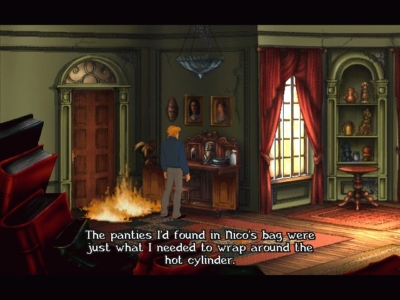

 Posts
Posts